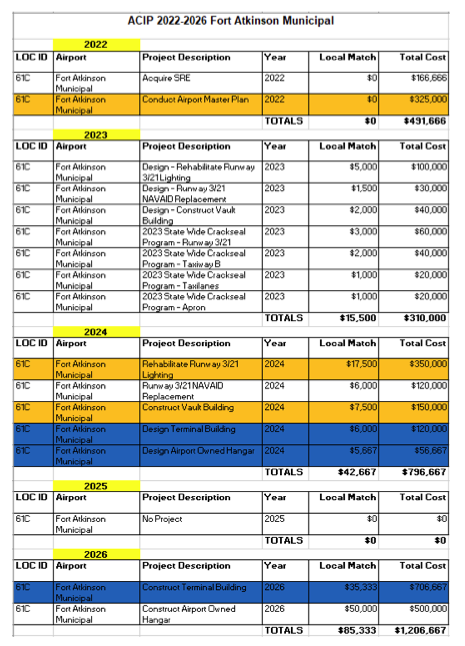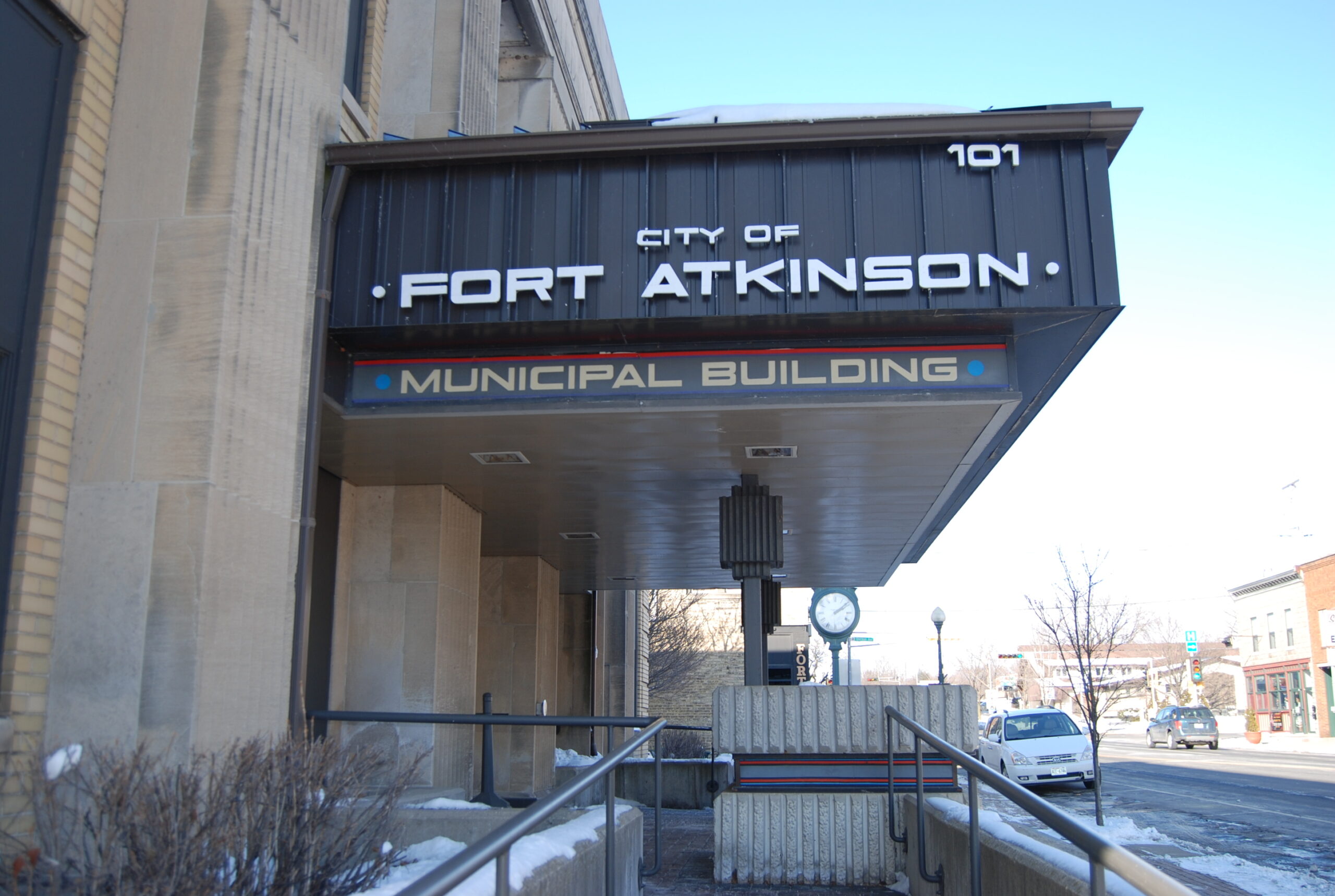By Chris Spangler
Plans for improvements to Fort Atkinson Municipal Airport could be taxiing down the runway soon.
The Fort Atkinson Plan Commission on Tuesday recommended that the city council petition the state Department of Transportation secretary for airport improvements aid.
Located between Fort Atkinson and Jefferson, the airport was built in 1948. According to city engineer Andy Selle, it averages 30 aircraft operations per day and, as of November, is home base for 24 aircraft.
The airport has a non-staffed, self-service refueling facility, providing aviation gasoline and Jet A fuels. The city reaps a 10-cent-per-gallon fuel tax that goes toward operations, along with hangar rental funds that totaled $16,000 last year.
“The airport has been updated throughout its 74 years, but is now in need of further upgrades, particularly to the runway, taxiways, apron, lighting and navigational aids and snow-removal equipment,” Selle wrote in a memo to the commission. “In addition, further capital improvements will enhance its use as a GA (general aviation) facility, resulting in more annual aircraft operations and making it more attractive to regional corporate aviation.”
He noted that discussions between the city and state Bureau of Aeronautics identified the following priorities:
• Acquire new snow-removal equipment.
• Replace/upgrade airfield lighting including guidance signs.
• Reconstruct/rehabilitate the apron.
• Reconstruct/rehabilitate taxiways/taxi lanes.
• Conduct an airport master plan and update airport layout plan.
• Potentially acquire land for airport development.
• Construct a city-owned hangar.
• Construct terminal/fixed-based operator building.
• Replace the rotating beacon.
• Replace/upgrade the apron and parking lot lighting.
• Improve airfield drainage.
• Fill cracks and sealcoat airfield pavement.
• Clear and maintain runway approaches according to state law and any necessary related work.
Selle noted that the first four items listed and the ninth through 12th items listed are maintenance-related expenditures that can proceed upon state approval of the petition, while the sixth through eighth items listed are longer-term capital improvements that would require developing a master plan to justify the monies.
“It (the airport) is a phenomenal piece of infrastructure and the reason for that is that it is well-funded by the FAA,” Selle told the commission during the meeting. “That money is administered through the Wisconsin Bureau of Aeronautics to accomplish various projects out at the airport. Those projects are literally everything that you could imagine that would be somehow related to an airport. We are asked on a relatively frequent basis to provide a list of projects that we would like to see move forward, and the commitment from the Bureau of Aeronautics is that they will essentially manage these projects for us and we would have significant input in them. They essentially do all the dirty work.”
The city’s commitment for these projects ranges from 3 to 5%, he said, adding, “It’s a very lucrative situation for the city to be in.”
Selle noted that the projects essentially fall into two categories: maintenance and capital expenditures.
“We have some significant capital investments that are kind of on our wish list, if you will. (As for) the potential new construction of hangars, we have requests about once every other week asking for hangar space out at the airport,” he said. “Land acquisition: There are some properties in the area that we would like to see acquired by the airport for future planning purposes. (Then there are) snow removal equipment and runway expansion.
“All of those sound very pie in the sky, but they do have some very real benefits to our airport as we look at it for the future. And that’s really governed by … the airport master plan,” Selle continued. “As we start talking about runway expansion, land acquisition, construction of hangars, terminal buildings (and) facilities, that requires some dedicated thought and, really, a long-term vision. And that’s what that master plan will force us to think about.”
According to Selle, it would take approximately $1.6 million to do all the maintenance projects, along with the master plan. Of that, about $58,000 would be required from the city. However, the city will be able to cover that using $75,000 in reimbursements of airport operational expenses under several COVID-related federal programs.
He said in his memo that future capital investments — which may be made in 2026, but only if justified by the master plan — would total $1.2 million, with a further local match of around $85,000. The latter would drop to around $68,000 by using the balance of the $75,000 reimbursement.
“If the whole program is implemented, $2.8 million in maintenance, upgrades and capital investments can be accomplished for a net investment by the city of $68,000 in out-of-pocket expense,” Selle said.
Commissioner Eric Schultz asked what benefit these projects will bring to the community.
“I would categorize the benefits in two levels,” Selle said. “There is a local benefit that is fairly small. We get calls fairly frequently from folks that are flying in their family; they’re going have dinner up the road, maybe they’re going to come into Fort and spend the night, see some friends or whatever and then head out. So those sort of trips are generated by the airport.”
In addition, the airport is home to local, private pilots, as well as the Wisconsin Skydiving Center and Chemair Helicopters.
“I would put that as a higher-level of benefit. We’re supporting companies and those companies have employees that live or work in the area,” Selle said. “When we start talking about investments out there with respect to extending taxiway, extending runways, building FBO (fixed-base operator) and a combination of having a gas station and a mechanic on site, that starts to get into the realm of corporate uses.”
Green Bay Packaging is one of the local companies that utilizes the airport for its corporate jets. It has indicated that the company would use the airport more frequently were there a longer runway, Selle said.
“It also allows us to have discussions about bigger items, such as locating an aviation business here. Now, that’s definitely a bit pie in the sky, but I can tell you we are able to have those discussions because of the availability of this money,” he said.
City Manager Rebecca Houseman LeMire emphasized that the first five items on the list of priorities are things that need to be done to continue the current use of the airport.
“So if we can get federal funds to assist with that, that is all the better, and then we’re not having to pay that cost individually or as a community through our taxes,” she said.
LeMire and Selle also pointed out that the snowplow would be housed in the city and could be used on streets when not at the airport.
“That is one of the direct impacts on the general fund and the taxpayers of the city, in a positive way,” Selle said.
Schultz made a motion to recommend city council approval of the resolution petitioning the secretary of transportation for airport improvements aid. This was seconded by Commissioner Jill Kessenich and unanimously approved.

A table, shown above, included within meeting packet materials shared with members of the Plan Commission Tuesday, outlines Capital investments, which may be made between 2023 and 2026, but, the information continued, only if justified by the Master Plan. Estimated costs of the various projects under consideration are shown in the table. A closer view of the table is here: http://fortatkinsononline.com/wp-content/uploads/2022/12/municipal-airport-chart-.pdf.
This post has already been read 2428 times!
